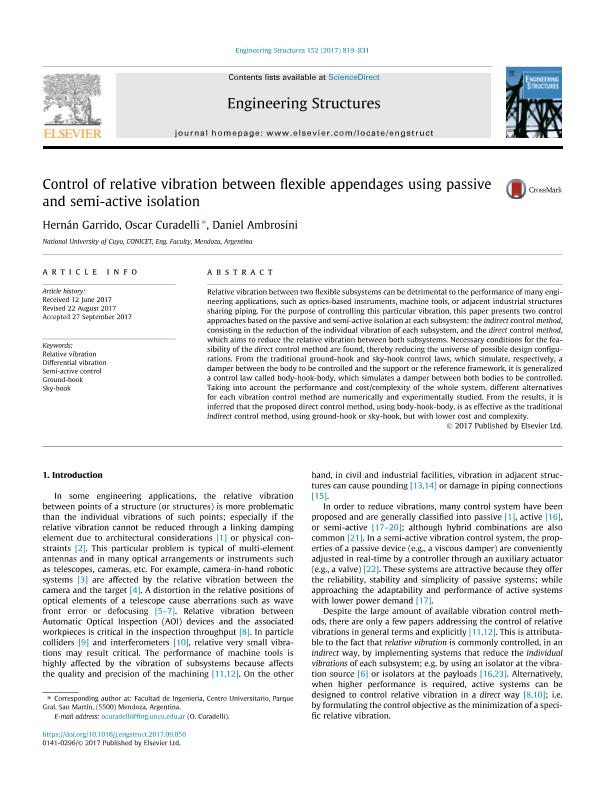Mostrar el registro sencillo del ítem
dc.contributor.author
Garrido, Carlos Hernán

dc.contributor.author
Curadelli, Raul Oscar

dc.contributor.author
Ambrosini, Ricardo Daniel

dc.date.available
2018-04-18T14:08:28Z
dc.date.issued
2017-12
dc.identifier.citation
Garrido, Carlos Hernán; Curadelli, Raul Oscar; Ambrosini, Ricardo Daniel; Control of relative vibration between flexible appendages using passive and semi-active isolation; Elsevier; Engineering Structures; 152; 12-2017; 819-831
dc.identifier.issn
0141-0296
dc.identifier.uri
http://hdl.handle.net/11336/42432
dc.description.abstract
Relative vibration between two flexible subsystems can be detrimental to the performance of many engineering applications, such as optics-based instruments, machine tools, or adjacent industrial structures sharing piping. For the purpose of controlling this particular vibration, this paper presents two control approaches based on the passive and semi-active isolation at each subsystem: the indirect control method, consisting in the reduction of the individual vibration of each subsystem, and the direct control method, which aims to reduce the relative vibration between both subsystems. Necessary conditions for the feasibility of the direct control method are found, thereby reducing the universe of possible design configurations. From the traditional ground-hook and sky-hook control laws, which simulate, respectively, a damper between the body to be controlled and the support or the reference framework, it is generalized a control law called body-hook-body, which simulates a damper between both bodies to be controlled. Taking into account the performance and cost/complexity of the whole system, different alternatives for each vibration control method are numerically and experimentally studied. From the results, it is inferred that the proposed direct control method, using body-hook-body, is as effective as the traditional indirect control method, using ground-hook or sky-hook, but with lower cost and complexity.
dc.format
application/pdf
dc.language.iso
eng
dc.publisher
Elsevier

dc.rights
info:eu-repo/semantics/openAccess
dc.rights.uri
https://creativecommons.org/licenses/by-nc-sa/2.5/ar/
dc.subject
Relative Vibration
dc.subject
Differential Vibration
dc.subject
Semi-Active Control
dc.subject
Ground-Hook
dc.subject
Sky-Hook
dc.subject.classification
Otras Ingeniería Civil

dc.subject.classification
Ingeniería Civil

dc.subject.classification
INGENIERÍAS Y TECNOLOGÍAS

dc.subject.classification
Ingeniería de Sistemas y Comunicaciones

dc.subject.classification
Ingeniería Eléctrica, Ingeniería Electrónica e Ingeniería de la Información

dc.subject.classification
INGENIERÍAS Y TECNOLOGÍAS

dc.subject.classification
Ingeniería de Sistemas y Comunicaciones

dc.subject.classification
Ingeniería Eléctrica, Ingeniería Electrónica e Ingeniería de la Información

dc.subject.classification
INGENIERÍAS Y TECNOLOGÍAS

dc.title
Control of relative vibration between flexible appendages using passive and semi-active isolation
dc.type
info:eu-repo/semantics/article
dc.type
info:ar-repo/semantics/artículo
dc.type
info:eu-repo/semantics/publishedVersion
dc.date.updated
2018-04-16T13:46:37Z
dc.journal.volume
152
dc.journal.pagination
819-831
dc.journal.pais
Países Bajos

dc.journal.ciudad
Amsterdam
dc.description.fil
Fil: Garrido, Carlos Hernán. Consejo Nacional de Investigaciones Científicas y Técnicas; Argentina. Universidad Nacional de Cuyo; Argentina
dc.description.fil
Fil: Curadelli, Raul Oscar. Consejo Nacional de Investigaciones Científicas y Técnicas; Argentina. Universidad Nacional de Cuyo; Argentina
dc.description.fil
Fil: Ambrosini, Ricardo Daniel. Consejo Nacional de Investigaciones Científicas y Técnicas; Argentina. Universidad Nacional de Cuyo; Argentina
dc.journal.title
Engineering Structures

dc.relation.alternativeid
info:eu-repo/semantics/altIdentifier/url/https://www.sciencedirect.com/science/article/pii/S0141029617319843
dc.relation.alternativeid
info:eu-repo/semantics/altIdentifier/doi/https://doi.org/10.1016/j.engstruct.2017.09.056
Archivos asociados
